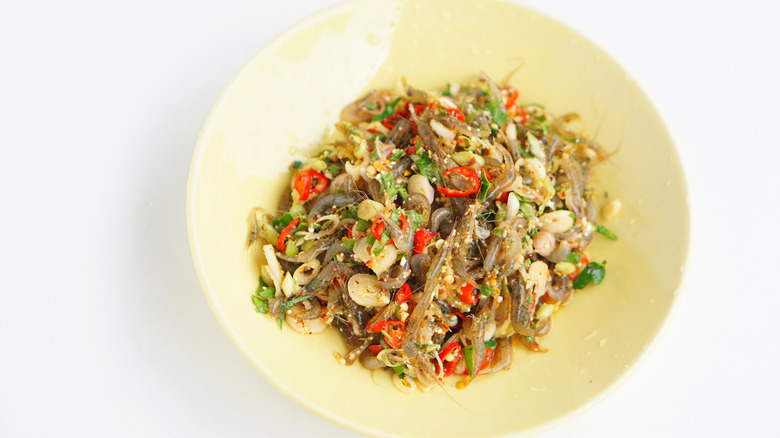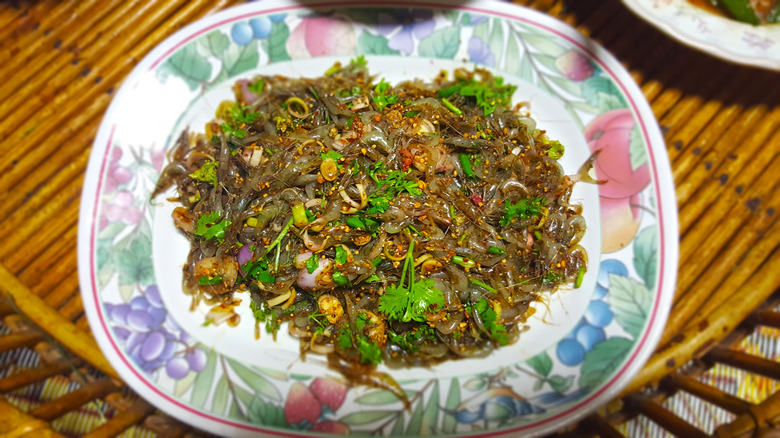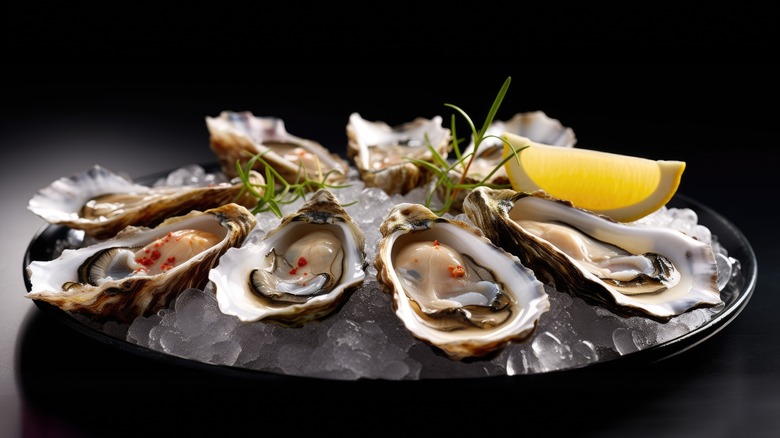The Wildly Unique Thai Salad Featuring Live Shrimp
Thai cooking is a rich cuisine filled with diverse flavors, proteins, and fusions with other foods and cultures. While several Thai dishes, such as pad thai, tom yum, khao soi, and tom kha, have found their way across the globe, there are many others that people who haven't visited Thailand may not have experienced. Among these, goong ten stands out for its unique nature.
Hailing from northeastern Thailand's Isaan region, goong ten ("dancing shrimp") is sold primarily by street vendors from carts with two-basket setups. One basket contains herbs, spices, and vegetables, while the other contains a small hammocked cloth filled with live freshwater shrimp, still very active and trying to escape. Sometimes, for even more freshness, the shrimp are kept in a tank, but either way, the results are the same — a spicy, flavorful dish you have to keep a lid on to keep the shrimp from literally jumping off the plate.
Goong ten can involve many flavors
Other than the region, we don't know much about goong ten's origins or why people started eating it. However, Isaan is famous for its intimate connection to the Mekong River, which runs along the province, separating Thailand from Laos. Giant catfish are often eaten from the river, but so are these tiny freshwater shrimp. The size is important: These aren't large tiger shrimp we're talking about but teeny little guys about the size of a sliver of onion.
@tiffanymoonmd Would you try some dancing shrimp salad? 🦐🥗 #JumpingShrimp #JumpingShrimpSalad #DancingShrimpSalad #ThailandFood #JoddFairs #BangkokStreetMarket
Seasonings can vary in dancing shrimp, but there are some commonalities. Fish sauce is always used, as are ground chilis, onions (typically shallots), and a healthy dose of lime juice. It can also include cilantro, mint, Thai basil, lemongrass, garlic, and sticky rice; There's no single, agreed-upon recipe that's considered the only authentic version. The shrimp are gathered up and mixed with the seasonings, either folded in carefully or simply shaken up a bit in the plastic or styrofoam serving container.
There are many live foods eaten around the world
There are many examples of animals that are eaten alive around the world. Spain has its famous casu marzu cheese (aka "maggot cheese"), Sardinian pecorino Romano that's been deliberately left out for flies to lay eggs in. The larvae are traditionally eaten alongside the cheese itself. Japan has ikizukuri (literally, "prepared alive"), in which any number of creatures, ranging from abalone to fish to frogs, are served sashimi-style while still living. Korea has sannakji, live octopus tentacles cut into pieces and served with sesame oil. (This one can be dangerous, as the suckers will sometimes fight on the way down, causing choking; Around six people die from eating this dish per year.)
However, the most common creature eaten alive around the globe is one you might've had yourself — oysters. Dozens of countries consume oysters on the half-shell, and while they may not be moving, they're very much still living. So, if you're ever in Thailand and you're looking for a unique gastronomic experience, give goong ten a try because it's really not that different from the live seafood you've already had.


